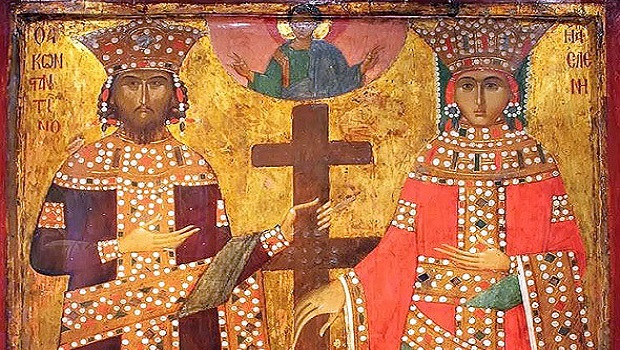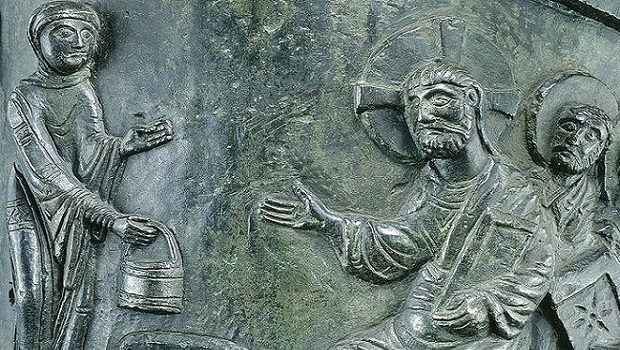Saint Kyranna was born in Avissoka, Thessaloniki, now known as Ossa in the region of Langada.
Her external beauty was commensurate to the internal beauty of her soul in that she was endowed with the virtues of modesty as well as prudence. And thus she lived, close to her parents. The malicious Evil One, however, loathed her for her purity, and, as he was unable with deceitful and sinful thoughts to beguile her into evil ways and turn her into one of his instruments, he therefore found another way to undermine the happiness of her family and the serenity of her pure young soul.
So, a Turk, a janissary, became infatuated with Kyranna. Now, this Turk was superintendent of the police station and an income-tax collector. Having fallen for Kyranna, he tried to win her over through various forms of cajolery. Kyranna totally rejected his blandishments and his fulsome promises of money and gowns. Nor was she swayed by his threats, that he would torture her cruelly and, finally, kill her unless she let him have his way.
The janissary’s persistence did nothing to change her Christian attitude. So the disappointed janissary, along with some others, seized the saint and took her to Thessaloniki. They brought her before the judge on a false charge of having first of all agreed to marry the Turk and change her religion, and then of changing her mind and deciding not to.
Her parents followed her to Thessaloniki. The Turks started the same tactics as before, first cajolery and then brutality. Kyranna, fearless, calm in the face of those who wanted to violate her free will, didn’t speak, other than to say simply: “I’m a Christian and my Lord Jesus Christ is my bride-groom, to whom I bring my virginity as my dowry; it was for him, and still is for him that I’ve yearned since I was very young; for His love I’m ready even to spill my blood, so that I may be worthy to rejoice in Him; so take note of my answer and don’t expect me to say anything else to you”.
After giving her reply, Kyranna bowed her head with great humility, remained silent and prayed in her heart to the Lord that He would give her the strength to endure her martyrdom to the very end.
When the Turks saw the extent of her faith in Christ they were shamefaced and threw her into prison. The policeman was granted permission by the Bey of the garrison of Thessaloniki, one Ali Efendi, to enter the prison whenever he wished. He went frequently, accompanied by other janissaries, and tortured her. One of them kicked her, one beat her with a cudgel or a knife, while yet another punched her, until she fainted. In the evening the jailer hung her in chains from her armpits and beat her with whatever was to hand, and left her hanging there in the bitter winter cold.
After the jailer had vented his spleen, a Christian warder approached him to ask if he could take the Saint down from her chains. The writer of her martyrdom makes the following observation: “Such was the Saint’s patience, so peaceful and quiet was she, that you’d have thought that someone else was suffering and not her, while her whole mind and prayer was in Heaven and with Christ”.
There were other Christians imprisoned in that same jail, as well as Jews and some Turkish women, all of whom reprimanded the prison guard for being ruthless and without any fear of God, since he’d viciously tormented a woman who’d done nothing wrong. And yet he became ever more cruel. The frightful sufferings continued for seven days.
On the seventh day, her sufferings came to a head. The guard was so enraged that he grabbed the Saint by the hair, hung her up and began to beat her mercilessly with a large, sharp wooden spike. The Turkish women screamed, the other prisoners all berated him and the guard himself fell flat on his face and started weeping.
At that moment, the saint breathed her last and her soul flew to be one with Christ, whom she had so desired and for whose sake she had been martyred. At about 4 or 5 o’clock that morning, a great light shone suddenly in the prison and came down from the rafters like lightning. This light enveloped the martyr’s body and the entire prison was bathed in light. The Christian prisoners shouted “Lord have Mercy”, the Jews fell on their faces and the Turkish women cried out: “Oh no, this is terrible! What’s been done to that poor Greek woman is going to affect us all and it’ll come back to haunt us”. The prison guard began to shake with fear and told the Christian warder to release Kyranna.
The warder found that Saint Kyranna had expired. The light very slowly faded, however an ineffable fragrance lingered for many hours throughout the whole prison. The warder unlocked the manacles, releasing the Saint’s arms, and then respectfully covered the Saint’s remains, lit the lights, censed her and sat by her until the break of day. He gave thanks to God that he had been fortunate enough to witness such miraculous things and to touch and to care for martyred relics.
That morning he spread the account throughout Thessaloniki of the Saint’s demise and of the shining of the Holy Light. The mortified Turks were silenced; they gave permission to the Christians to remove the relics of the Saint and the Christians were filled with joy and gladness at the wonders of the True and Living God.
They buried her outside Thessaloniki at the place where the graves of all the other Orthodox Christians were, and her garments they distributed among the faithful as a blessing. It was 28 February 1751.
Source: pemptousia.com
ABOUT THE ORTHODOX CHRISTIAN NETWORK
Orthodox Christian Network (OCN) is a 501(c)3 and an official agency of the Assembly of Canonical Bishops of the United States of America . It is a recognized leader in the Orthodox Media field and has sustained consistent growth over twenty-two years. We have worked to create a community for both believers and non believers alike by sharing the timeless faith of Orthodoxy with the contemporary world through modern media. We are on a mission to inspire Orthodox Christians Worldwide. Click to signup to receive weekly newsletter.
Join us in our Media Ministry Missions! Help us bring the Orthodox Faith to the fingertips of Orthodox Christians worldwide! Your gift today will helps us produce and provide unlimited access to Orthodox faith-inspiring programming, services and community. Don’t wait. Share the Love of Orthodoxy Today!
OCN has partnered with Pemptousia. A Contemporary post-modern man does not understand what man is. Through its presence in the internet world, Pemptousia, with its spirit of respect for beauty that characterizes it, wishes to contribute to the presentation of a better meaning of life for man, to the search for the ontological dimension of man, and to the awareness of the unfathomable mystery of man who is always in Christ in the process of becoming, of man who is in the image of divine beauty. And the beauty of man springs from the beauty of the Triune God. In the end, “beauty will save the world”.




0 Comments